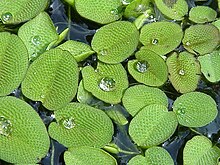| Salvinia | |
|---|---|

| |
| Salvinia minima | |
| Scientific classification | |
| Kingdom: | Plantae |
| Clade: | Tracheophytes |
| Division: | Polypodiophyta |
| Class: | Polypodiopsida |
| Order: | Salviniales |
| Family: | Salviniaceae |
| Genus: | Salvinia Ség. |
| Type species | |
| Salvinia natans (L.) All.
| |
| Species | |
|
See text | |
Salvinia or watermosses[1] is a genus of free-floating aquatic ferns in the family Salviniaceae. The genus is named in honor of 17th-century Italian naturalist Anton Maria Salvini, and the generic name was first published in 1754 by French botanist Jean-François Séguier in Plantae Veronenses, a description of the plants found around Verona.[2] Twelve species are recognized, at least three of which (S. molesta, S. herzogii, and S. minima) are believed to be hybrids in part because their sporangia are found to be empty.
Salvinia is related to the other water ferns, including the mosquito fern Azolla. Recent sources include both Azolla and Salvinia in Salviniaceae, although each genus was formerly given its own family.
Salvinia, like the other ferns in order Salviniales, are heterosporous, producing spores of differing sizes. However, leaf development in Salvinia is unique. The upper side of the floating leaf, which appears to face the stem axis, is morphologically abaxial.[3]
Salvinia cucullata is one of just two fern species for which a reference genome has been published.[4]
- ^ USDA, NRCS (n.d.). "Salvinia". The PLANTS Database (plants.usda.gov). Greensboro, North Carolina: National Plant Data Team. Retrieved 28 October 2015.
- ^ Pl. Veron. 3: 52. 1754.
- ^ J. G. Croxdale 1978, 1979, 1981.
- ^ Li, Fay-Wei; Brouwer, Paul; Carretero-Paulet, Lorenzo; Cheng, Shifeng; de Vries, Jan; Delaux, Pierre-Marc; Eily, Ariana; Koppers, Nils; Kuo, Li-Yaung (2018-07-02). "Fern genomes elucidate land plant evolution and cyanobacterial symbioses". Nature Plants. 4 (7): 460–472. doi:10.1038/s41477-018-0188-8. ISSN 2055-0278. PMC 6786969. PMID 29967517.